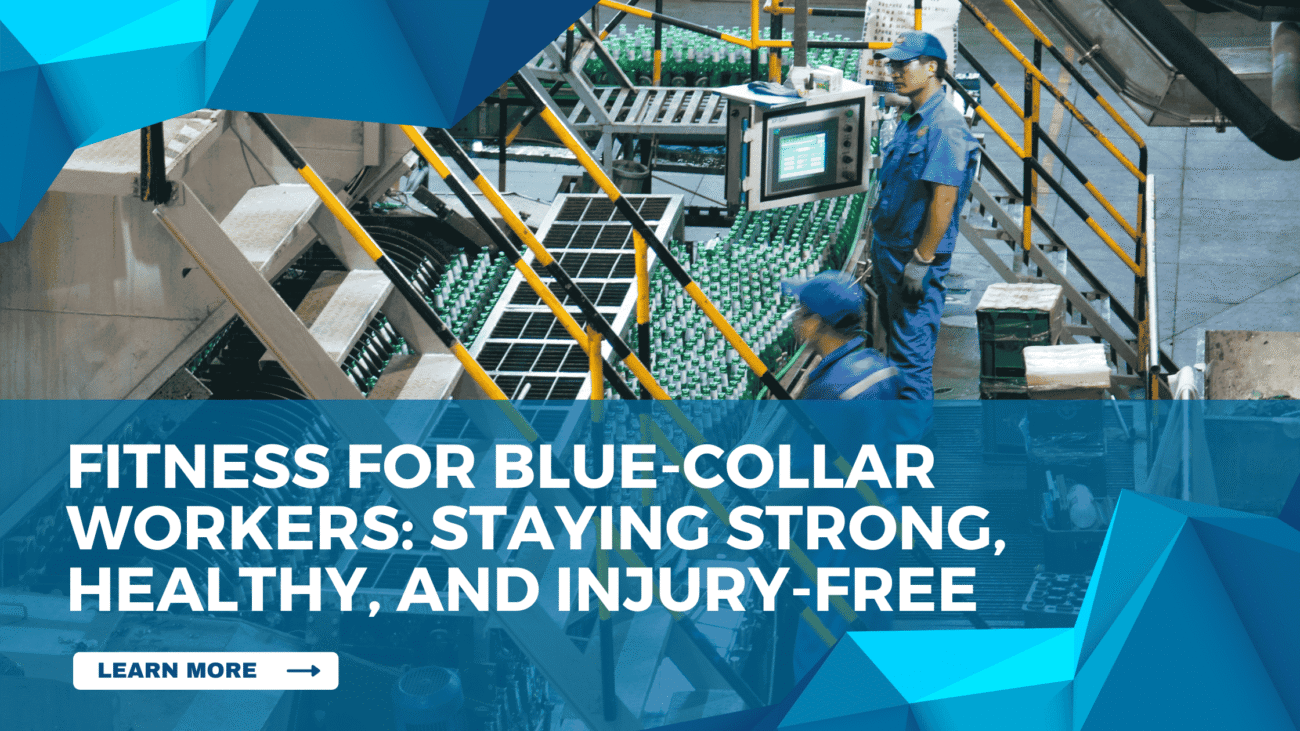Blue-collar workers are naturally better fitted because the nature of the job is physical. Whether the work involves heavy lifting, being on your feet for extended periods, or working with machinery, the occupation of manual labor requires strength, stamina, and resilience.
However, despite having hectic work schedules, blue-collar workers themselves are more likely to experience chronic pain, fatigue, and injury if they do not make their health a point of conscious intention. This post provides practical on-the-job fitness tips for blue-collar workers, highlighting the impact of small lifestyle changes on improved performance, injury prevention, and overall health benefits. By combining occupational strength with smart fitness programs, employees can create permanent health dividends away from the workplace.
Why Fitness Is Important to Blue-Collar Workers?
Physical Demands of Hand Labor
Unlike office work, blue-collar jobs involve repetitive movement, heavy lifting, kneeling, bending, or working in awkward positions. These activities, if performed repeatedly, can strain muscles and joints progressively, leading to chronic back pain, shoulder trauma, or premature arthritis.
Mental and Emotional Benefits

Fitness is not just bodily, but also a method of managing stress, improving sleep, and reducing the threat of mental burnout. Staff members who labor long hours or overtime may become exhausted, which introduces performance and safety issues. Training regulates energy and mood, making the working day bearable.
Longevity and Injury Prevention
Most workers retire early because of musculoskeletal injuries. By staying mobile, building stabilizing muscles, and stretching every day, blue-collar workers can lengthen their careers and safeguard their long-term health.
Fitness Challenges Unique to Blue-Collar Workers
Fatigue After Long Shifts
After a grueling 8–12-hour workday, it’s understandable to feel too exhausted for formal exercise. But avoiding purposeful fitness altogether can make workers weaker in the long term.
Uneven Muscle Use
Work causes overuse in some muscle groups. For example, roofers overuse their knees, and construction workers their backs. Without balance training, this leads to overuse injuries.
Irregular Work Schedules
Most jobs that involve manual labor have rotating shifts or overtime. This makes it difficult to maintain regular workout and sleeping habits.
Limited Access to Fitness Centers
Workers may not have time or resources for the gym. The exercises need to be cost-effective and require minimal equipment or no equipment at all.
Practical Blue-Collar Fitness Recommendations
1. Warm Up Pre-Work
In spite of the active nature of work, pre-work warm-up decreases the possibility of strains. A 5–10 minute warm-up improves blood flow and flexibility.
- Arm circles, shoulder rolls, and torso twists to improve upper body mobility
- Light squats and lunges for lower body preparation
- Light hamstring and back stretches
2. Strength Training Outside of Work
Manual work develops strength, but frequently in repetitive, imbalanced patterns. Complementary strength training develops the strength groups that function less at work, developing stability and injury resistance.
- Core exercises: planks, dead bugs, bird dogs
- Leg strength: squats, step-ups, glute bridges
- Upper body: push-ups, resistance band rows, pull-ups
Even two 20-minute sessions per week will make a significant contribution to resilience.
3. Prioritize Flexibility and Mobility
Jobs that include bending, kneeling, or climbing restrict mobility in the long term. Incorporating stretches reverses the range of motion.
- Hip flexor stretches
- Hamstring stretches
- Shoulder openers and chest stretches
Yoga or dynamic stretching programs can also reverse stiffness.
4. Focus on Recovery and Sleep
Recovery is all too frequently overlooked. Sleep is the repair system of the body, and without it, muscles are fatigued, increasing injury risk.
- Opt for 7–9 hours of night sleep
- Use foam rollers or a massage device on fatigued muscles
- Apply heat/cold therapy as needed to soreness
5. Enduring Energy Nutrition
Blue-collar workers expend many calories yet survive on fast food or convenience machine snacks. Better nutrition powers energy and reduces fatigue.
- Pre-work fueling: oatmeal, bananas, or eggs for sustained energy
- On-the-job treats: nuts, jerky, protein bars, fruit
- Hydration: water or electrolyte beverages over soda or energy drinks
Post-work recovery: lean protein and vegetables to rebuild muscles
6. Preventive Care for Joints and Back
- Wear the right shoes with arch support
- Wear braces or supports if a doctor recommends
- Add safe lifting practices: bend knees, not waist
- Strengthen stabilizers such as abs and glutes to help shield the spine
A Sample Weekly Exercise Plan for Blue-Collar Workers
Day 1: Strength Training (20–30 minutes)
- Push-ups: 3 sets of 10–15
- Squats: 3 sets of 15
- Resistance band rows: 3 sets of 12
- Plank: 30–60 seconds hold
Day 2: Recovery and Mobility (15 minutes)
- Back, hamstring, and shoulder stretching routine
- Foam rolling
Day 3: Cardio (20–25 minutes)
- Brisk walk, cycling, or light jog
Day 4: Strength Training (20–30 minutes)
- Step-ups: 3 sets of 12 per leg
- Glute bridges: 3 sets of 15
- Bird dogs: 3 sets of 10 each side
- Side planks: 20–30 seconds per side hold
Day 5: Active Recovery
- Yoga, mobility drills, or walking
Day 6: Optional Cardio/Strength Combination
- Circuit: squats, push-ups, rows, planks (complete 3 rounds)
Day 7: Rest
Resting will relax your body and allow you to function better.
Long-Term Rewards of Fitness for Blue-Collar Workers
- Reduced Pain and Injury – Strength and flexibility shield the body from repetition-induced strain.
- Improved Job Performance – More strength and stamina make the job simpler and less hazardous.
- Better Quality of Life – Energy to work with the family, recreation, and non-occupational activities.
- Longer Career Life – Workers can stay in the job longer without injury, necessitating premature retirement.
- Better Mental Health – Exercise decreases stress and enhances mood, allowing workers to cope with demanding schedules.
Blue-collar fitness isn’t about becoming a “gym body” but about maintaining the one body you have to keep working, living, and thriving.





